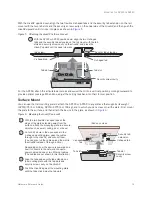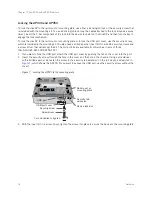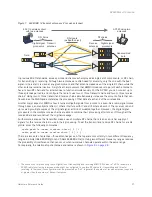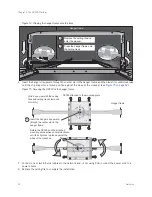
Hardware Reference Guide
27
AP340 P
RODUCT
O
VERVIEW
Figure 7 2x2 MIMO (2 transmit antennas x 2 receive antennas)
In previous 802.11 standards, access points and clients each employed a single set of components, or RF chain,
for transmitting or receiving. Although two antennas are often used for diversity, only the one with the best
signal-to-noise ratio is used at any given moment, and that antenna makes use of the single RF chain while the
other antenna remains inactive. A significant improvement that MIMO introduces is to permit each antenna to
have its own RF chain and for all antennas to function simultaneously. For the AP340, you can connect up to
three antennas per radio and configure the radio to use two or three transmit chains and two or three receive
chains.
1
Using two or three transmit and receive chains simultaneously increases the amount of data that can
flow across the WLAN and accelerates the processing of that data at each end of the wireless link.
Another major aspect of MIMO is how it turns multipath signals from a curse to a boon. As a radio signal moves
through space, some objects reflect it, others interfere with it, and still others absorb it. The receiver can end
up receiving multiple copies of the original signal, all kind of muddled together. However, the digital signal
processors in the multiple receive chains are able to combine their processing efforts to sort through all the
received data and reconstruct the original message.
Furthermore, because the transmitter makes use of multiple RF chains, there is an even richer supply of
signals for the receive chains to use in their processing. To set the transmit and receive RF chains for a radio
profile, enter the following commands:
radio profile <name> transmit-chain { 2 | 3 }
radio profile <name> receive-chain { 2 | 3 }
There are two sets of antennas—three antennas per set—that operate concurrently in two different frequency
ranges: 2.4 GHz (IEEE 802.11b/g/n) and 5 GHz (IEEE 802.11a/n). Using two different frequency ranges reduces
the probability of interference that can occur when numerous channels operate within the same range.
Conceptually, the relationship of antennas and radios is shown in
1. The convention for presenting the configuration of transmitting and receiving MIMO RF chains is TxR. For example, a
AP340 radio functioning in access mode might be configured to use two RF chains for transmitting and three for
receiving. In that case, its configuration can be presented as "2x3". In general, the number of receive antennas is equal to
or greater than the number of transmit antennas.
Transmit
antennas
Digital signal
processors
RF chains
RFsignals
(multipath object)
Receive
antennas
Digital signal
processors
RF chains
802.11n wireless client
with two antennas
AP340 using two
antennas
Data
Reassembled
data
Содержание Aerohive APs
Страница 1: ...Aerohive Hardware Reference Guide ...
Страница 7: ...Contents 6 Aerohive ...
Страница 17: ...Chapter 1 The AP330 and AP350 Platforms 16 Aerohive ...
Страница 47: ...Chapter 3 The AP320 Platform 46 Aerohive ...
Страница 61: ...Chapter 4 The AP170 Platform 60 Aerohive ...
Страница 91: ...Chapter 8 The High Capacity HiveManager 90 Aerohive ...
















































